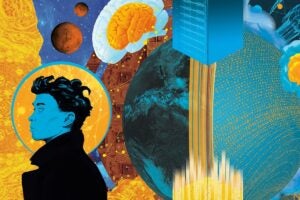Why exactly is Pokémon Go such a phenomenon?
Just ask this Longhorn.
“The game itself is intended to facilitate the real-life stuff,” says John Hanke, CEO of Niantic, the game’s developer. “It’s an icebreaker.”
But before Hanke helped create the biggest game of the year that millions of fans across the globe are playing, he was a student on the Forty Acres.

Hanke earned a Bachelor of Arts degree in 1989 after studying in the College of Liberal Arts. As a Plan II student, Hanke completed a challenging interdisciplinary arts and science honors major. The Plan II program teaches students to solve problems, write and think critically and analytically.
Hanke talked about the game’s record-breaking popularity in a recent interview with Business Insider.
“It gives people a reason to spend time together,” Hanke says.

UT Austin is covered with Poke Stops and gyms.
Plan your visit to campus with our Summer Guide to the Forty Acres, and you’ll find more than just a rare catch and ample items.

On the Forty Acres, nostalgic Pokémon players who remember the games from years past and newcomers who are just discovering the series are connecting over the game.
“We honored the spirit of the original [Pokémon] game,” Hanke says.
Walk around campus, and you’ll quickly notice students, faculty, staff and visitors in search of Pokémon. Stop by the Turtle Pond, and you’ll meet other Pokémon trainers huddled in the shade while staring at phones.
The players share tips and advice while debating their allegiances to game’s different teams. Pokémon Go, they say, can be a fun break from studying, a way to liven up a long walk across campus, a healthy way to explore landmarks and even an avenue to make new friend.

Hanke knew Pokémon Go would be a hit, but it’s gotten bigger than even he expected, with the game having as many as 21 million daily active users in the U.S. alone.
Pokémon Go, The New York Times says, represents “one of those moments when a new technology… fuses digital technology with the physical world [and] breaks through from a niche toy for early adopters to something much bigger.”
“We expected it to be popular, but we didn’t expect it to be like this,” Hanke says.
The turtle pond at @UTAustin has attracted a ton of Pokemon Go trainers. Very cool to see people having this shared experience!
— Grady Bailey (@GB330033) July 13, 2016
And if the past week is any indication, Pokémon Go isn’t just a fad — it’s here to stay, and the technology behind the game could change the world.
“Pokémon Go isn’t really a game. It’s a new technology,” Vox Technology writer Ezra Klein says. “Augmented Reality (AR) begins with Pokémon. It begins as a toy. But it won’t remain a toy. It’s going to become an industry, a constant, a coping mechanism, a way of life. It will change how we spend our time, how we compete for status, how we interact with our loves ones. It will change the behaviors we think of as normal… [and] it won’t be long until AR cuts across other fault lines in our society.”

Now let’s hope Hanke can help us catch a Tauros…. (and, yes, we’ll name it Bevo)



